In my last story posted here, “Explorations in Oregon’s Andrews Experimental Forest,” I described some adventures during a two-week residency in October, 2019. My opportunity to be there was thanks to the Spring Creek Project for Ideas, Nature, and the Written Word, a collaboration between Oregon State University and the US Forest Service. I was a “visiting scholar” and writer-in-residence, with my only commitment being to contribute a “reflection” to The Forest Log, a record of the impressions of artists, poets, writers, and philosophers meant to be a parallel to the rich record of scientific observations at the Andrews. I was tasked, as it were, with trying my best to bridge the often-imagined “divide” between science and the arts and humanities. In my previous story I argued that is a false dichotomy, but also an urgent challenge. I vented my views on all that in that posting, so won’t recap them here.
In trying to bring together both science and poetry, to “walk the high ridge,” between what have been described as the “two cultures,” I decided to approach my contribution to The Forest Log as a series of questions, taking as my model a poetic form invented by the Chilean poet, Pablo Neruda (1904-1973). His El libro de las preguntas, The Book of Questions, was his last work, finished only months before his death. It is a series of imaginative and often fanciful questions – preguntas in Spanish – that are mostly poetic rather than scientific. Here is an example from Neruda:
¿Cuál es el pájaro amarillo que llena el nido de limones?
Which is the yellow bird that fills its nest with lemons?
I have found his poetic model to be a natural jumping-off point for “ecopoetics” or “ecopoetry”: We can take a real observation (data, science), formulate a question about it, state that in a poetic and imaginative way (following Neruda), and leap to another level of emotional and/or philosophical inquiry. To me, Neruda’s preguntas are akin to Japanese haiku poetry, which has its philosophical roots in Zen koan – the answerless riddles that nevertheless point the way to deep psychological and spiritual insights. Each of the Neruda-inspired questions from the Andrews Forest I posed was a launching pad – an opening image or excuse – for an eco-philosophical exploration.
One such question was “What promise, Pacific yew, did you make to moss that she wraps you so tenderly in her pale green robes?”
The Pacific yew, Taxus brevifolia, is common in the understory of the Andrews Forest, and throughout the Pacific Northwest. Yews are often draped like Druids in robes of moss. This species has garnered worldwide attention because of the anti-cancer drug Taxol, derived from a compound discovered in its bark (a fascinating story of applied scientific sleuthing too long to tell here). My question in the Andrews Forest was leaning toward whether the answer was some kind of an evolutionary quid pro quo that scientists still don’t understand. And could it have anything to do with Taxol?
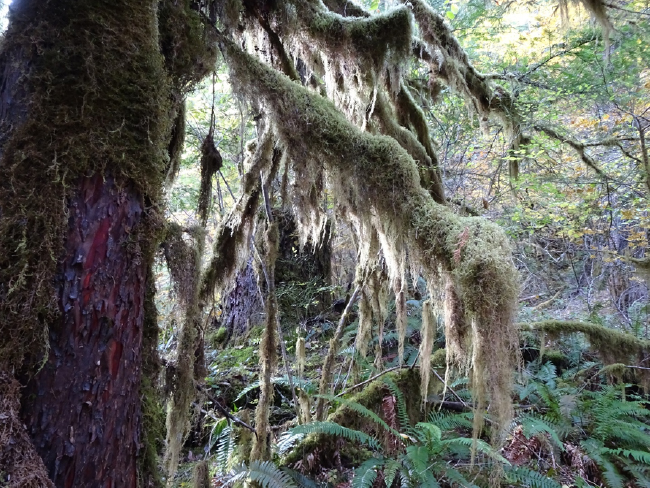
So, I googled and dug into the scientific literature, looking for an answer. A paper in the prestigious journal Science, from 1993, “Taxol and taxane production by Taxomyces andreanae, an endophytic fungus of Pacific yew,” teed up the question. The fungus is found in the living tissue of the inner bark of the tree, called the phloem, the plumbing system through which nutrients are transported up from the roots and sugars from photosynthetic needles are transported down. Taxomyces andreanae belongs to a still somewhat mysterious group of organisms called the Hyphomycetes, which are now classified as fungi. Similar to the ectomycorrhizal fungi that form symbiotic connections with the roots of trees and exchange nutrients in evolutionary quid pro quos underground, hyphomyceteous fungi do it under the bark, interacting with the phloem of the tree. That creates an intimate connection between tree and fungal symbiont, one in which tissues and cells merge and meld… This sounds, perhaps, to be leading in a phyto-erotic, sexual direction? When that merging and melding happens, could genes perhaps be exchanged between fungus and tree? Exchanging genes is what sex is all about, of course… At least in evolutionary terms, I mean.
Then a 2015 research article titled “An Endophyte Constructs Fungicide-Containing Extracellular Barriers for Its Host Plant” really started to stretch this story in an interesting evolutionary direction. Sameh Soliman and his six co-authors say that “A mystery has been why both the tree and its resident non-pathogenic fungi (endophytes) synthesize Taxol, apparently redundantly.” So… the tree itself, and the fungus intimately associated with its phloem (under the bark, in the dark) both seem to be synthesizing the same very unusual and unique biochemical substance? That sounds a bit suspicious, doesn’t it? Maybe what we have here is a conspiracy, collusion, a quid pro quo; a plot to influence the next attack by…. Wood Decaying Fungi! In the article, the authors explain that “Yew trees (Taxus) hyperbranch from long-lived buds that lie underneath the bark, resulting in persistent bark cracking and deep air pockets, potentially allowing pathogens [wood-decaying fungi] to enter the nutrient-rich vascular system …” They talk about these fungal attackers so much in the report that they give them an abbreviation, WDF.
But the scientific mystery doesn’t stop with why both tree and endosymbiotic fungus both make Taxol. Soliman and colleagues go on to propose that “the endophyte [fungus] might be evolutionarily analogous to animal immune cells, in that it might expand plant immunity by acting as an autonomous, anti-pathogen sentinel that monitors the vascular system.” What they found was that the fungus “not only responds to pathogen [WDF] ingress, but just like circulating immune cells in an animal, the fungus can be deployed specifically to sites of infection where it releases a potent anti-microbial compound [Taxol].”
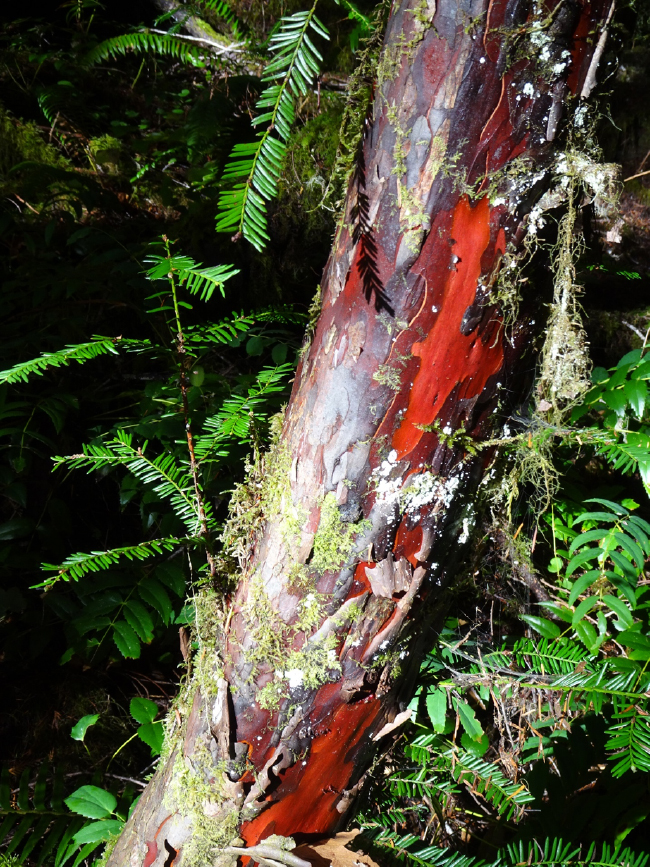
Uh oh! This sounds like time to review a few ideas from David Quammen’s 2018 book The Tangled Tree: A Radical New View of Life. Quammen, a masterful science and nature writer, describes the robust scientific evidence that now suggests that some traits have leaped across the branches of the “tree of life” through “horizontal gene transfer,” providing a pathway to evolutionary adaptation that couldn’t have been imagined in Darwin’s theory that he called “descent with modification.” Organisms may be bound more deeply in a web of “reticulate evolution” than Darwin and his descendants could imagine. Now, gene-sequencing technology is helping evolutionary biologists untangle the tangles of the tree of life. We can see now that branches of the biotic family tree may not only diverge, but sometimes grow together; cooperating, merging and melding, sharing genes.
I’m only speculating here – so far, the scientific literature gives no answer – that the strange fact that both Pacific yews and Taxomyces andreanae synthesize Taxol might be a potential case of evolution by horizontal gene transfer and the “radical new view of life” Quammen has described. Not to mention the question about why the fungus marshals a mobile defense of the tree against wood-decaying fungi, similar to animal immune systems.
But back to my original question about why moss loves Pacific yew: What promise, Pacific yew, did you make to moss that she wraps you so tenderly in her pale green robes? Maybe, just maybe (everything is connected, after all), the same characteristic that makes the Pacific yew a target for wood-decaying fungi (e.g., trunk budding, deep bark cracking, air pockets in the bark) make it friendly to moss, which cloaks it in its blessed green robes. Maybe the moss, too, helps fend off the deadly WDF, intercepting fungal spores that would otherwise find their way to the inner sanctum of the phloem?
——-
Another of my Neruda-inspired questions from the Andrews Forest was “Why are rough-skinned newts so cute and so laced with poison?”
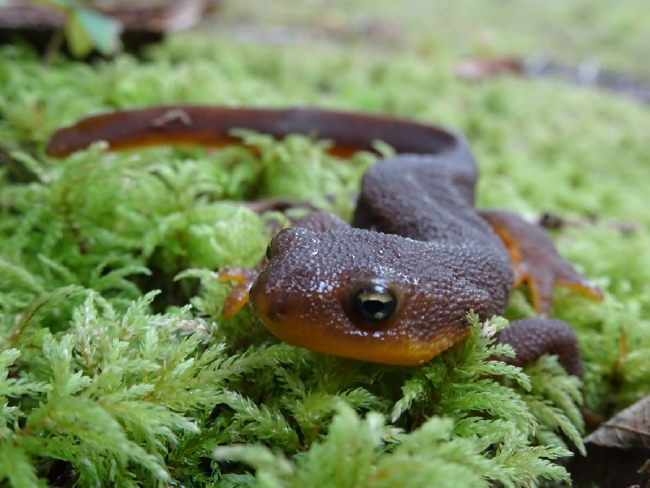
The rough-skinned newt, Taricha granulosa, is the official mascot of the Andrews Experimental Forest and is pictured on its logo. Every day on my afternoon run through the Forest Service’s Mona Campground, a half-mile down the road from the Andrews Headquarters where I stayed, I saw from half a dozen to dozens of them, depending on the weather. They apparently like to hang out on the campground road, and my informal research showed they love rainy days.
They are so cute! I don’t know, maybe it’s something about their big eyes and curious expressions? And they are full of one of the deadliest neurotoxins ever invented by evolution: tetrodotoxin. This is the same toxin found in several species of pufferfish, and that has also been found in ribbon worms, seastars, an octopus, and a Costa Rican frog. Why?
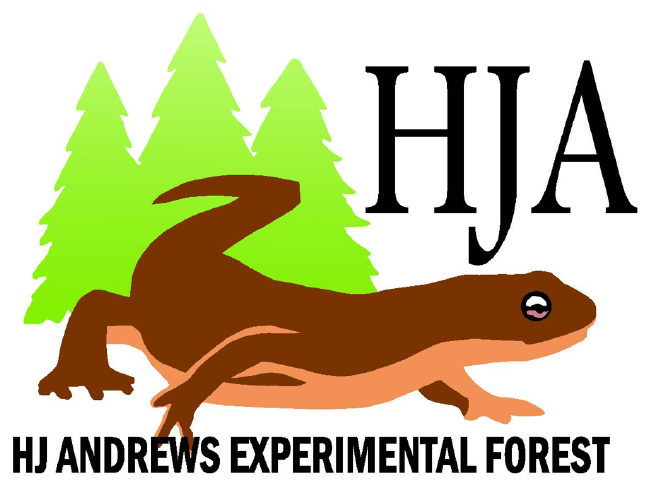
How did species as distantly related as spiny pufferfish and cute newts come to have the same deadly neurotoxin? Well, evolution is creative and entrepreneurial, and can reinvent the wheel again and again, as needed. “Convergent evolution,” evolutionary biologists call it, when from different trajectories on the tree of life similar solutions are evolved. Maybe… that would have been my automatic response until recently. But for tetrodotoxin, the scientific literature leads me down a more complicated path, the same path I was led down when learning about Taxol. In a scientific report from 2011 titled “On the origins and biosynthesis of tetrodotoxin,” Chau and his coauthors say “Here we review the sources of tetrodotoxin described to date and provide evidence for the biosynthesis of tetrodotoxin by symbiotic microorganisms in higher taxa.” Symbiotic microorganisms, like bacteria, in “higher organisms” like, say, newts and pufferfish? Jorge Lago and his colleagues reported in 2015 that “the origin of tetrodotoxin is unknown, but in the pufferfish, it seems to be produced by endosymbiotic bacteria…”
Uh oh! I just described the endosymbiotic relationship between the Pacific yew and its Taxol-producing endosymbiotic fungus. This evidence about the evolutionary story of tetrodotoxin makes me wonder whether it could join Taxol as an example of how traits have leaped across the branches of the tree of life through horizontal gene transfer, in the intimate interspecies assignations of endosymbiosis.
——-
Every time I lay on my belly, face to face, eye to eye, for a conversation with a cute newt, I couldn’t help thinking about E.T. Yes, that’s right: the “extra-terrestrial” who landed on Earth in the 1982 movie “E.T. the Extra-Terrestrial.” E.T., like the newts, was somehow cute.
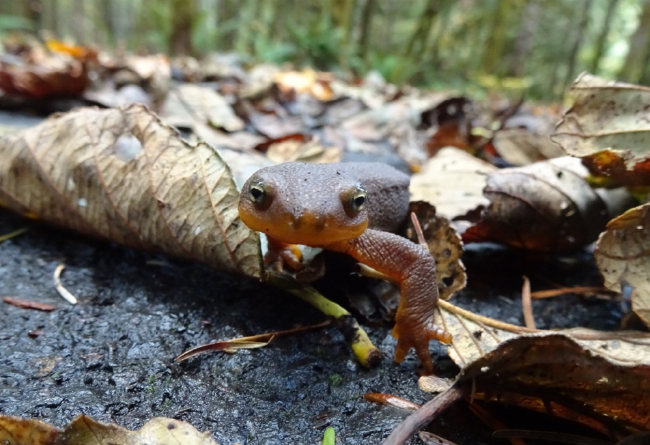
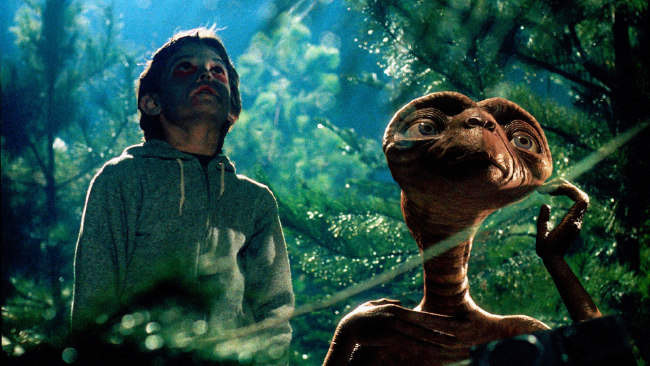
Time and time again during my couple of weeks exploring the Andrews Forest, I came upon research sites with arrays of strange scientific gear: three-pronged stainless-steel spikes on tripods, rivers of wires running up the trunks of giant Douglas-firs to instruments so high up I couldn’t see them, delicate leaf-like sensors to measure surface moisture in the forest understory, belts of wire to measure the diameter of trees to the millimeter, temperature loggers sheltered under half-rounds of white PVC pipe, groundwater wells to measure hyporheic flow along streams. What flashed in mind was that if an extraterrestrial exploring expedition from an alien planet happened to touch down in the Andrews, they might deploy a mysterious array of sensors that would look very similar to what human scientists have deployed here, now.
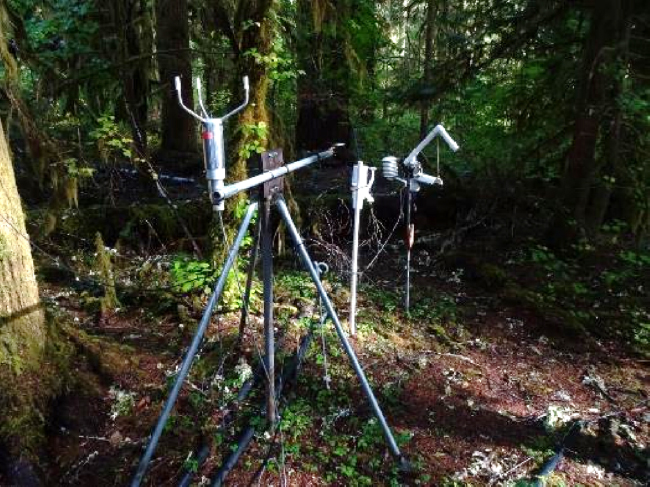
Perhaps not so far-fetched an image, I came to think. Scientists in the Andrews are trying to understand the functioning of an ecosystem on a planet which, although we inhabit it, we barely know at all. These strange gizmos and gadgets scattered through the Andrews Forest are the tools of my own species – and I thought: we are alien invaders also, in these ancient ecosystems that evolved without our presence for hundreds of millions of years.
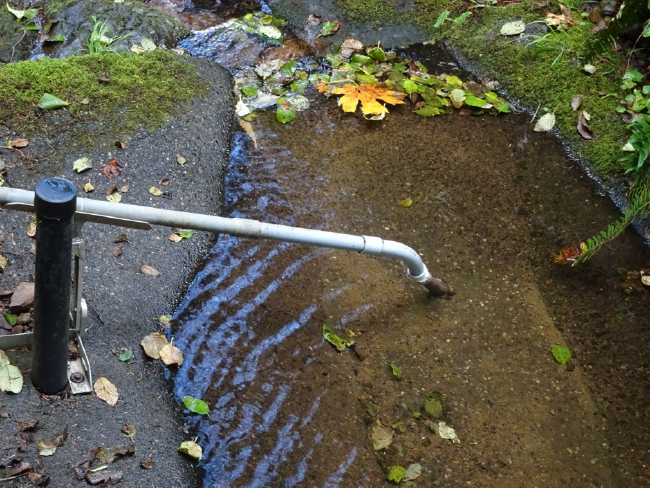
If an extraterrestrial species were to have a chance at colonizing another living planet, and constructing a sustainable colony there, they would have to first understand the living system into which they proposed to insert themselves. So far, our human species, which exploded out of Africa an eyeblink ago in evolutionary time, has failed to do that. We are like alien invaders from space as far as most ecosystems of Earth, including the Andrews Forest, are concerned.
Some reductionist ecologists these days seem to think that we can reconstruct functioning ecosystems after we’ve destroyed them – or even construct them from scratch. In a disturbing opinion piece in the September 2017 issue of Frontiers in Ecology and the Environment, the monthly publication of the Ecological Society of America, an ecologist from Texas A&M University (who shall remain unnamed by me here) wrote: “The time when ecological science is deliberately applied to reconstruct components of the natural world at a much broader scope may arrive sooner than you think. Imagine building, replicating, and manufacturing functional ecosystems across multiple scales, from managing selected flora in the human gut with a pill to terraforming planetary bodies across the cosmos [emphasis added].” I responded to the anthropocentric hubris of that view with a letter criticizing and challenging its fundamental assumptions, titled “Ecology, the humbling science,” which was published in April 2018 in ESA’s Frontiers.
My question in the Andrews Forest was “With lifetimes more questions still to ask here, can anyone talk seriously about ‘terraforming’ Mars?” We don’t know enough. We still don’t know, after seventy years of science at the Andrews, how this amazing, mysterious forest functions. We have some preliminary glimpses, but we don’t know enough to know what we may have to do to keep it functioning. We keep learning new things on a regular basis. And if we don’t know how ecosystems work well enough to keep from further damaging them, how could we possibly imagine “building, replicating, and manufacturing functional ecosystems” from scratch?
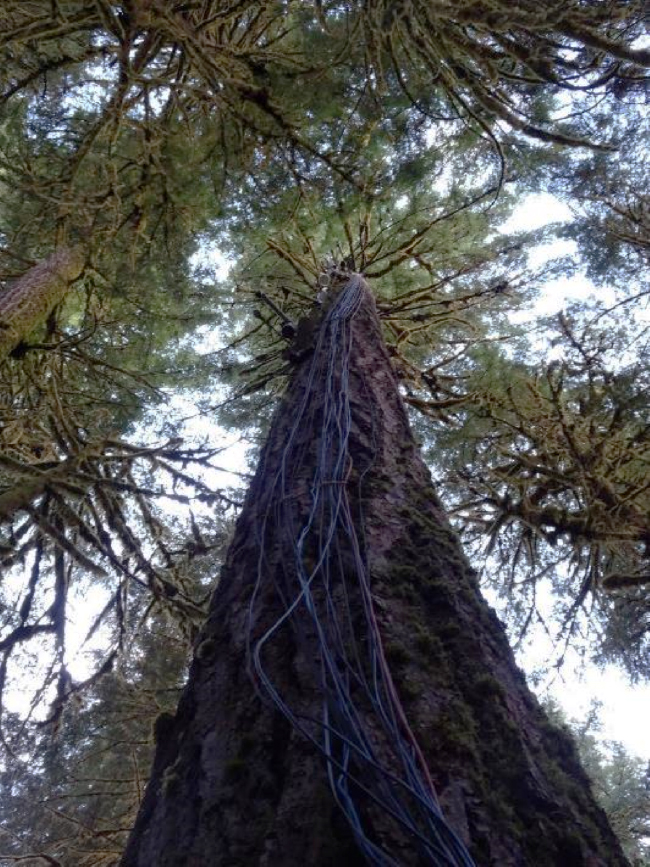
Maybe that’s why the strange tripods in the forest, sampling tubes sucking streams, and wires going up into huge ancient trees made me smile. Maybe we can study and understand this planet, this ecosystem, this forest, before we destroy it (and thereby destroy ourselves). Here, at least, we are trying. Our curiosity and resolve to understand our own home planet are, for me, a sign of hope.
For related stories see:
Sources and related links:
- The Forest Log.Long-Term Ecological Reflections Program, Spring Creek Project, Oregon State University.
- Byers, Bruce A. 2019. “Ten Questions in the Andrews Forest.” The Forest Log. Spring Creek Project, Long-Term Ecological Reflections Program, Oregon State University.
- Pacific Yew, Taxus brevifolia.
- Stierle, A; Strobel, G; Stierle, D (1993). “Taxol and taxane production byTaxomyces andreanae, an endophytic fungus of Pacific yew.” Science 260 (5105): 214-216.
- “A Story of Discovery: Natural Compound Helps Treat Breast and Ovarian Cancers.” NIH National Cancer Institute: Research. March 2015.
- Soliman, Sameh S.M., et al. 2015. “An endophyte constructs fungicide-containing extracellular barriers for its host plant.” Current Biology 25: 2570–2576.
- Talbot, Nicholas J. 2015. “Plant Immunity: A Little Help from Fungal Friends.” Current Biology 25, R1070–R1091, November 16, 2015.
- Quammen, David. 2018. The Tangled Tree: A Radical New History of Life. New York: Simon & Schuster.
- Rough-skinned newt, Taricha granulosa.
- Chau R, Kalaitzis JA, Neilan BA (Jul 2011). On the origins and biosynthesis of tetrodotoxin. Aquatic Toxicology. 104 (1–2): 61–72.
- Lago J, Rodríguez LP, Blanco L, Vieites JM, Cabado AG (2015). Tetrodotoxin, an Extremely Potent Marine Neurotoxin: Distribution, Toxicity, Origin and Therapeutical Uses. Marine Drugs. 13 (10): 6384–406.
- Image from “E.T. the Extra-Terrestrial” movie (1982).
- Byers, Bruce A. 2018. “Ecology, the humbling science.” Frontiers in Ecology and the Environment, April 2018. Ecological Society of America.

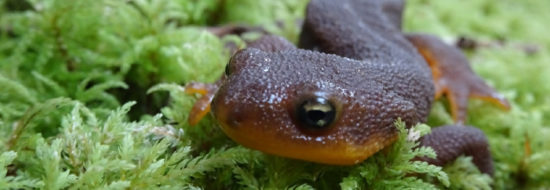



March 1, 2020 10:00 am
Truly thought-provoking. Reading this article has equipped me with new insights to share with my next class taking an evolutionary biology course that I have been teaching for the last two years. Although I took it up reluctantly when one of our old professors retired, I would give up anything else to keep it. Both the students and I are constantly amazed at how simple explanations become about ordinary observations in life when one switches on the evolution lens.
March 6, 2020 12:38 am
Thank you, Evans. I am sure you are leading your students well in applying “the evolution lens.” That is a great phrase, by the way! David Quammen’s book probably gives too much detail about the scientific history of the discoveries of horizontal gene transfer and reticulate evolution for your students to understand easily, but I suspect you can convey the main messages to them. I assume his book is easily available to you in Kenya?
March 6, 2020 12:40 am
This story elicited a number of responses, both fun and philosophical (in keeping with the title, I suppose). In fact, I think only my posting Anthocynology at Westminster, my musings about evolution and behavior from the Westminster Kennel Club Dog Show in February, 2015, stimulated more comments. At the time, I attributed that to dogs being humans’ “best friends.” Maybe cute newts take second place?
Carol English wrote: “Thanks for the interesting information on the rough-skinned newt. I spent time recently in northern California where I grew up. In December I went up to our old swimming pool, which is now a California newt mini-ecosystem! Same genus as yours, different species. I helped one get out of the pool and didn’t wash my hands. I then licked my finger while making coffee. The taste was so bitter and horrible. I immediately realized what I’d done. I think I did have a reaction (shortness of breath and elevated heart beat). I called poison control and they said I’d need to eat part of it to die! That was in December, and I recently returned to witness them mating, which I’d learned about decades ago while working in Yosemite National Park. I’ve attached a video. Yosemite National Park has excellent information on how the newts reproduce.” Her video of a swirl of mating newts is here: https://youtu.be/VZFEJiyR_vY.” The species Carol encountered, the California newt, Taricha tarosa, is a southern cousin of the rough-skinned newt, a sibling species, which also defends itself with tetrodotoxin.
Chris Rurik wrote: “I really, really love this piece, from the Neruda shout out to your discussion of horizontal gene flow. I recently published a short piece using my observations of the rough-skinned newt as a way of encouraging my (non-scientific) readers to imagine all the ways there are of perceiving a forest.” Chris’s philosophical commentary, A Newt’s World, was published in the local newspaper of his home ecosystem, the Key Peninsula in Puget Sound, Washington.
Steve Fox pointed out that taxol “was used to treat ovarian cancer initially; breast and lung came later.” As I mentioned in the story, the history of the discovery of taxol is a success story of bioprospecting – a deliberate sifting through the library of biochemicals evolution has invented to look for biological “gold” – novel and unique biological compounds – that may have medical benefits as new drugs. As I said in my blog, this is too long a story to tell here, but it is truly fascinating. Google it up if interested.